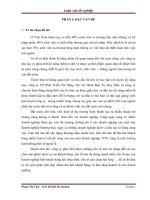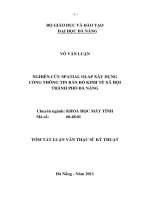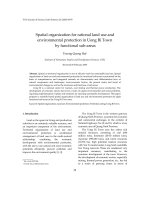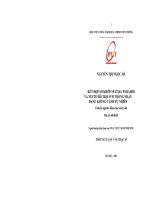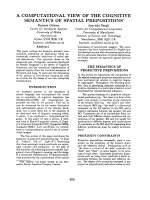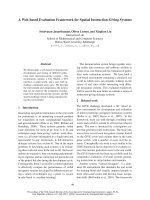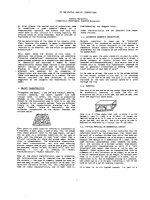2019 spatial thinking
Bạn đang xem bản rút gọn của tài liệu. Xem và tải ngay bản đầy đủ của tài liệu tại đây (543.64 KB, 12 trang )
<span class="text_page_counter">Trang 1</span><div class="page_container" data-page="1">
<b><small>Some of the authors of this publication are also working on these related projects:</small></b>
<small>Promoting teachers' professional competencies in the context of Education for Sustainable Development in VietnamView project</small>
<small>Education for Sustainable Development in Geography Teaching in VietnamView project</small>
<small>All content following this page was uploaded by Thao Nguyen on 02 January 2020.</small>
<small>The user has requested enhancement of the downloaded file.</small>
</div><span class="text_page_counter">Trang 2</span><div class="page_container" data-page="2">Perspective of Spatial Thinking
<i><b><small>To cite this article: Ngoc-Anh Nguyen et al 2019 IOP Conf. Ser.: Earth Environ. Sci. 338 012042</small></b></i>
<small>View the article online for updates and enhancements.</small>
</div><span class="text_page_counter">Trang 3</span><div class="page_container" data-page="3"><small>Content from this work may be used under the terms of theCreative Commons Attribution 3.0 licence. Any further distributionof this work must maintain attribution to the author(s) and the title of the work, journal citation and DOI.</small>
<b>Reviewing Spatial Thinking in Geography Textbooks Questions from The Perspective of Spatial Thinking</b>
<small>1</small>Faculty of Geography, Hanoi National University of Education, Vietnam
<small>2</small>Department of Geography, Grosvenor Center for Geographic Education, Texas State University, USA
<small>3</small>Institute of Didactics in Geography, Münster University, Germany
Email:
<b><small>Abstract. As a science and a subject in school, geography is considered as having a major role </small></b>
<small>to play in fostering spatial thinking. In the context of preparing for an educational reform transferring from content-based to competency-based approach in Vietnam now, spatial thinking is identified as one of the prominent competencies that geography can promote. However, there has been no research on spatial thinking in the country so far. Therefore, this paper aims at reviewing spatial thinking in geography textbooks from grade 6 to grade 9 in Vietnam for the reason that geography is taught as a separate and compulsory subject in secondary and high school. We adapt the Taxonomy of Spatial Thinking proposed by Jo and Bednarz (2009) and then simplified by Scholz et al. (2014) to evaluate spatial thinking in three aspects: the concepts of spatial, tools of representation and processes of reasoning in questions in textbooks. The findings show that the majority of questions in textbooks are non-spatial thinking. The research gives suggestions for textbook authors in Vietnam to take three dimensions of spatial thinking into account in the future geography curriculum reform. Besides, it recommends teachers to consider to foster not only spatial thinking but also effective questioning in their teaching. </small>
<b>1. Introduction </b>
1.1. Spatial thinking and its components
Spatial thinking has gained the growing interest over the last decades. (Goodchild, 2006) [1] argue that apart from the three Rs – reading, writing, arithmetic, spatial literacy should be added as the fourth R because it is also an essential and basic function of the skills-oriented education program in schools. Spatial thinking is not confined to a single domain of knowledge; alternatively, it is a matter of concern ranging from psychology and pedagogy to GIScience (Wakabayashi & Ishikawa, 2011) [2]. Especially, it has important application to science, technology, engineering, arts, and mathematics (STEAM). Spatial thinking has been identified as a common component in all Earth sciences, such as Geography, Geology and Environmental Science (Zwartjes et al., 2016) [3]. In the Theory of multiple intelligences by Howard (2006) [4], spatial intelligence is considered as one of the distinct modalities of intelligence; however, this theory mainly articulates spatial intelligence in relation to arts subjects. Until now, there has been no universal definition and model of spatial thinking.
[5,6,7,8,9,10,11,12,13,14]. Some of them search for cognitive psychology and neuroscientific base for spatial thinking. Notably, Robson (2012) [13] proposes three main stages of developing spatial competence among children: egocentric representation – in relation to ourselves and our own position; landmark representation – in relation to landmarks in the environment; allocentric representation – in relation to using an abstract frame of reference such as maps, coordinates. Gersmehl & Gersmehl (2008, 2011) [11,14] examine neuroscientific foundation for spatial thinking and describe eight models of spatial thinking based on reviewing research in neuroscience of spatial cognition: Spatial
</div><span class="text_page_counter">Trang 4</span><div class="page_container" data-page="4">comparisons, spatial influence (aura), spatial groups (region), spatial transition, spatial hierarchy, spatial analogies, spatial pattern, spatial associations (correlations).
The National Research Council (NRC) (2006) [15] describes spatial thinking as a form of thinking including a collection of cognitive skills. The key to spatial thinking is a fusion of three elements: concepts of space, tools of representation, and processes of reasoning (National Research Council, 2006, p. 12). NRC identifies three characteristics of spatial literacy including a habit of mind of thinking spatially, practising spatial thinking in an informed way, and adopting stance to spatial thinking.
Geography, as a science and a subject at school, deals with spatial thinking in a close relationship. Geography is a study of places with the focus on two sub-disciplines physical and human geography. However, these two sub-disciplines are not studied separately, but in a relationship. Geography investigates the spatial distribution, the variation and the relationship between attributes of human and natural system. For that reason, on the one hand, special thinking is vital in geography; on the other hand, geography can promote spatial thinking. Goodchild & Janelle (2011) [16] emphasize the role of spatial thinking from geopolitical view: firstly, commerce and politics planning can be affected by “location and geography patterns of resource distributions and market”; secondly, navigation ability is critical to both individuals’ daily survival and geopolitical fortunes of nations. German Geographical Society (DGfG) confirms the role of spatial thinking in geography education when identifying spatial orientation as one of six key competencies in geography because of its geographical foundation and its high degree of social relevance. Bednarz & Lee (2011), Lee & Bednarz (2009, 2012), Solem, Huynh & Boehm (2014) and Ishikawa (2016) [10,17,18,19,20] provide evidence suggesting that GIScience can promote spatial thinking in students.
1.2. Taxonomy to evaluate spatial thinking components
A taxonomy to evaluate the components of spatial thinking has been proposed by Jo and Bednarz (2009) [9] and then simplified by (Scholz, Huynh, Brysch, & Scholz, 2014) [21]. This taxonomy has been applied in studies evaluating questions in geography textbooks in high school and university by the same authors.
Based on spatial thinking definition of NRC (2006) [20], Jo and Bednarz (2009) [9] develop a taxonomy including three components: concepts of space, tools of representation, and processes of reasoning; each component contains subcategories. The table 1 summarizes components of spatial thinking based on research of Jo and Bednarz (2009) and Scholz, Huynh, Brysch, & Scholz (2014) [9, 21].
<b>Table 1. Components of spatial thinking by Jo and Bednarz (2009) and Scholz, Huynh, Brysch, & </b>
Scholz(2014)
<i><b>Component 1: Concepts of space </b></i>
<i>Jo and Bednarz (2009) base on the scheme of spatial concepts and classifications of Golledge (1995,2002) [5,22] to divide four subcategories. </i>
- <i><b>Non-spatial: no spatial component in the question </b></i>
- <i><b>Spatial primitives: the lowest level concept of space, </b></i>
involves the concepts of location, place-specific identity, and/or magnitude
- <i><b>Simple-spatial: a higher concept of space, based on </b></i>
concepts and distributions derived from spatial primitives, including distance, direction, connection and linkage, movement, transition, boundary, region, shape, reference frame, arrangement, adjacency, and enclosure.
- <i><b>Complex-spatial: the highest level concepts of space, </b></i>
based on distributions derived from spatial primitives and high-order derived concepts including distribution pattern,
</div><span class="text_page_counter">Trang 5</span><div class="page_container" data-page="5">dispersion and clustering, density, diffusion, dominance, hierarchy and network, spatial association, overlay, layer, gradient, profile, relief, scale, map projection, and buffer.
<i><b>Component 2: Tools of representation </b></i>
<i>This component related to the use of maps, graphics and other representations to answer a question </i>
- <i><b>Use: the question involves a tool of representation to </b></i>
answer the question
- <i><b>Non-use: the question is not considered a spatial-thinking </b></i>
question
<i><b>Component 3: Process of reasoning </b></i>
<i>This component evaluates the cognitive level of a question. </i>
- <i><b>Input: The lowest level – receiving of information and </b></i>
includes name, define, list, identify, recognize, recite, recall, observe, describe, select, complete, count, and match.
- <i><b>Processing: A higher level of reasoning, analyzing </b></i>
information, includes: explaining, analysing, stating causality, comparing, contrasting, distinguishing, classifying, categorizing, organizing, summarizing, synthesizing, inferring, analogies, exemplifying,
experimenting, and sequence.
- <i><b>Output: </b></i> The highest level of processes of reasoning, uses the analysis of information received to evaluate, judge, predict, forecast, hypothesize, speculate, plan, create, design, invent, imagine, generalize, build a model, or apply a principle.
In this article, we adapt the simplified taxonomy created by Scholz et al., who in turn used the taxonomy developed by Jo and Bednarz, to review spatial thinking in geography textbooks' questions from grade 6 to grade 9 in Vietnam. The paper gives suggestions for textbook authors in Vietnam to take three dimensions of spatial thinking into account in the future geography curriculum reform. Additions, wegive examples of questions containing spatial thinking from low to very high level and questions of nonspatial-thinking in Vietnam geography textbooks.
<b>2. Methodology </b>
2.1. Proposing a new taxonomy
We keep elements to evaluate Concepts of Space and Tools of representation in the taxonomy by Jo and Bednarz, and Scholz et al. Regarding Process of Reasoning, we employ another instrument to access this process.
The taxonomy of Jo and Bednarz evaluates the process of reasoning based on the model of intellectual functioning by Costa [23], including three levels of thinking: input, processing and output. In this study, we replace the model of intellectual functioning proposedby Costa with the Structure of Observed Learning Outcome (SOLO) cognitive processing taxonomy to assess the third component of spatial thinking - process of reasoning. The reason is that we want to employ a competence approach in the evaluation and the SOLO taxonomy enables measuring the quality of students’ work based on their learning outcomes.
The SOLO taxonomy was created by analyzingthe structures of students’ responses, including quantitative and qualitative attributes, to assessment tasks [24,25]. The taxonomy makes it possible to identify the type of thinking in the student’s cognitive process [26]. It has taken into account elements affecting student learning: students’ prior knowledge and misconceptions, motives and intentions
</div><span class="text_page_counter">Trang 6</span><div class="page_container" data-page="6">regarding education, and their learning strategies and has been proved in terms of psychological basis and (Hattie & Brown, 2004, p.6).
The SOLO taxonomy describes four levels of learner’s understanding with increase complexity: surface and deep (Table 2).
<b>Table 2. SOLO taxonomy categories </b>
understanding
Surface
<b>Unistructural: students have a limited </b>
knowledge of the topic and they may deal with one single aspect.
<i>Example question: What is the highest mountain of Vietnam? </i>
Identify, name, count, recite, recall Follow simple procedure
<b>Multistructural: students are likely to able to </b>
understand several aspects, but there is a lack of connection among them.
<i>Example question: What are the names of eight planets in the Solar system? </i>
Combine, describe, enumerate, list, match, select
Perform serial skills
Deep
<b>Relational: several aspects are linked and </b>
integrated into a whole and students can have a coherent understanding around a related topic.
<i>Example question: Why is winter in the </i>
<i>Northwest and North Central regions (Vietnam) shorter and warmer than winter in the </i>
<i>Northeast? </i>
Analyze, apply, argue, compare, contrast, summarize, organize, categorize, distinguish, criticize, explain, relate, justify
<b>Extended abstract: the coherent whole can be </b>
generalized to new domains.
<i>Example question: If Vietnam did not border the East see, how would the weather in Vietnam be? </i>
Create, design, event, formulate, generate, hypothesize, reflect, theorize, forecast
We have a new taxonomy to evaluate spatial thinking as (figure 1).
</div><span class="text_page_counter">Trang 7</span><div class="page_container" data-page="7">We have chosen geography textbooks from grade 6 to grade 9 in Vietnam for evaluation because geography is taught as a separate and compulsory subject in secondary and high school. It is worth noting that there is only one textbook set for all levels of education published by the Vietnam Education Publishing House in the country. The contents of the textbooks mentioned above cover a wide range of themes from physical geography to human geography. To be more specific, textbook 6 (geography textbook for grade 6) introduces the Earth and the components of the Earth system. Textbook 7 (geography textbook for grade 7) includes three main parts: human geography, geographic environments, and nature and human in continents (Africa, America, Antarctica, Australia, and Europe). Textbook 8 (geography textbook for grade 8) includes two main parts: nature and human in continents (Asia), and physical geography of Vietnam. Textbook 9 (geography textbook for grade 9) introduces human geography of Vietnam.
Unistructural Multistructural Relational <sup>Extended </sup><sub>Abstract </sub>
</div><span class="text_page_counter">Trang 8</span><div class="page_container" data-page="8">Each textbook present questions at the end of each lesson and chapter. There are 1056 questions included in the four textbooks. Textbook 6 includes 185 questions, textbook 7 includes 293 questions, textbook 8 includes 296 questions, and textbook 9 includes 282 questions.
2.3. Coding
The questions containing non-spatial concept (e.g., “When did Vietnam become a member of ASEAN?”) and those that do not require the use of tools to answer (e.g., “How is weather different from climate?”), were identified as non-spatial thinking questions. The remainders were spatial-thinking questions. The latter were classified into four levels (Figure 2).
- Low level: questions ranked as SPU, SPM, and SSU - Medium level: questions ranked as SPR, SSM, and CSU - High level: question ranked as SPE, SSR, and CSM - Very high level: questions ranked as SSE, CSR, and CSE.
<i>Following is a specific example of spatial thinking questions: “Based on the geological-mineral map (in Atlas of Vietnam) or the map of Vietnam's physical geography map and your knowledge, analyze the relationship between the distribution of mineral resources and the distribution of some key industries”. (Textbook 9, page 39). This question uses a tool (map), reflects the distribution pattern </i>
and spatial association (complex spatial), and requires students to analyze the relationship between two objects (relation). Consequently, it was evaluated as a spatial thinking question.
2.4. Inter-rater reliability
To test inter-rater reliability, each set of questions is evaluated independently by two authors. The agreements and disagreements in the evaluation were used to calculate Cohen’s Kappa. The results for calculating as following: Concepts of space: Kappa = 0.872 (p < 0.001); Tools of representation: Kappa = 0.923 (p < 0.001); Process of reasoning: Kappa = 0.812 (p < 0.001). This reflects that the evaluation gain almost perfect agreement.
<b>3. Results </b>
3.1. Concepts of space
It is noticed that a large number of questions in the textbooks do not contain concepts of space (Table 3). The percentages are very high in Grade 9 (75.2%) and Grade 7 (68.6%). In questions containing concepts of space, the majority of them deal with simple-spatial concepts. Questions related to complex-spatial concepts account for a very modest proportion in all textbooks.
3.2. Tools of representation
It is very easy to observe that there is little difference between the percentages of non and use-questions in all textbooks, with the exception of Grade 7. However, the proportion of use-questions using tools of representation is slightly higher than those of questions not using tools (Table 3).
3.3. Process of reasoning
A striking point is that there is no question in four textbooks featuring an extended abstract level of reasoning. That means higher order thinking skills proposed in SOLO, such as create, formulate, forecast, etc. have not been presented in textbook questions. More than 50% of the questions are at the Multistructural level. Unistructural level accounts for a modest proportion. The percentage of Relational level varies between 28.7% (Grade 7) and 39.0% (Grade 9). All in all, the overwhelming majority of the questions in the textbooks are in the surface level of understanding – requiring a lower cognitive process. Students, therefore, rarely are promoted to develop their higher-order thinking through answering questions.
</div><span class="text_page_counter">Trang 9</span><div class="page_container" data-page="9"><b>Table 3. Statistics on spatial-thinking questions in geography textbooks </b>
3.4. Integration of all components
Approximate one-third of the questions are classified as spatial-thinking questions. Of those, medium and low levels are the most commonly found. Few high-level questions are given to integrate some aspects of knowledge and skills and allow students gain a coherent understanding. Very high-level questions are seldom placed in textbooks.
Two-third of the questions do not feature all three components. However, it should be noticed that many questions do not require using tools of representation to answer, but they contain concepts of
<i>space (e.g., “Where are ethnic minorities mainly located?”,textbook 9). Similarly, many questions </i>
require students to use tools of representation to answer, but they do not contain concepts of space
<i>(e.g., “Based on figure 18.1, the economic map of the North mountainous area and your understanding, draw a diagram showing the relationship between the production and consumption of coal products for the purposes of being fuel for thermal power plants, domestic consumption and export”, textbook 9). Ifwe want to use the questions to promote spatial thinking in students, it would </i>
be necessary to integrate all three components of spatial thinking into a question.
Overall, textbook 6 shows the highest proportion of spatial-thinking questions (43.2%) and the highest proportion of very high-level questions. Textbook 8 come next (35.5%). The lowest proportion of spatial-thinking questions are 29.4% in textbook 7 and 22.3% in textbook 9, respectively.
<b>4. Discussion and conclusion </b>
Almost half the questions in the textbooks do not require students to use tools of representation to answer the questions. This suggests textbook authors to utilize the use of representations in textbooks
</div><span class="text_page_counter">Trang 10</span><div class="page_container" data-page="10">to help students “remember, understand, reason and communicate about the properties of and relations between objects represented in space” [15]. In other words, representations in the text should not be only considered as demonstration of knowledge. Alternatively, they should be regarded as sources of knowledge. It is worth to notice that a large number of questions requiring the use of tools are presented in “practice lessons”. The geography curriculum in Vietnam includes general lessons and “practice lessons”. “Practice lessons” deal with questions of analyzing a data table, drawing an outline map of Vietnam, filling in a blank map, drawing graphs, etc. Although this kind of questions integratestools of representation, it may not fulfil the optimum role of tools of representation: “reason and communicate about the properties of relations between objects represented in space”. Along these lines, we propose that using tools of representation may have different levels. Possible need for clarification of different levels will certainly require further studies.
The questions under this study feature the higher percentage of them at the surface level of thinking (Unistructural and Multistructural) and a lower percentage at the deep level of thinking (Relational). In contrast, the highest level of thinking skills – Extended abstract – does not appear in the questions. Consequently, this fact might suggest to textbook authors to implement questions that include higher order thinking skills, adding the requisite for the students to perform at an Extended abstract level. Furthermore, the same fact might suggest to geography teachers to integrate challenging questions in their teaching. This new strategy should maintain the condition of promoting high-level cognitive processes. As an example, we take the case of textbook 6 which allow the students learn about the movements of the Earth and its effects. This textbook gives information on rotation, revolution, and the effects of each movement. The lesson includes some questions at the end. Among the questions
<i>there are two at relational level because they require students to explain the phenomenon: “Why is there the formation of day and night on the Earth?” and “Why does revolution cause alternate seasons on the Earth?” Teachers may pose some other questions that are somewhat more challenging to students. For example, “What would happen if the Earth did not rotate around its own axis and just moved around the Sun?” or “What would happen if the Earth spun backwards?” This kind of </i>
questions challenges students to deal with a hypothesis and go beyond the available information in the textbook.
In relation to concepts of space, almost all the questions include complex spatial concepts that share one common aspect. They ask students to comment/recognize the distribution pattern of objects
<i>represented in maps/figures, (e.g., “Observe figure 3.1, the map of population distribution and urban of Vietnam in 1999, give a comment on the distribution of cities in our country”, textbook 9). Other </i>
concepts of complex-spatial such as dispersion and clustering, density, diffusion, dominance, hierarchy and network, spatial association, overlay, layer, gradient, profile, relief, scale, map projection, and buffer rarely are presented in the textbooks. This raises a call for authors to diversify concepts of space in textbooks.
Vietnam has been prepared for new educational reforms that will transform the learning process from a content-based approach to a competency-based approach (Nguyen, 2017, p.4) [27]. Resolution No. 29-NQ/TW of November 04, 2013 on “Fundamental and comprehensive innovation in education, servingindustrialisationand modernization in a socialist-oriented market economy during international integration” has been adopted with the focal focus on developing competencies for students. In this context, identifying competencies in geography is crucial. Spatial thinking is one of the prominent competencies that geography can promote. This study gives suggestions for textbook authors in Vietnam to take three dimensions of spatial thinking into account in the future geography curriculum reform. Besides, it recommends teachers to consider not only spatial thinking but also effective questioning in their teaching.
</div>